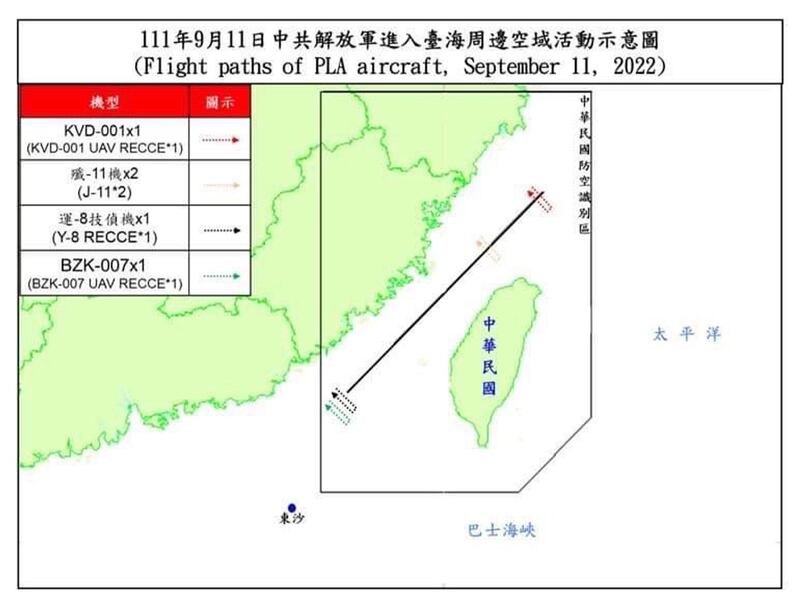The Chinese military has intensified its drone incursions into the skies above Taiwan with almost daily flights of combat and reconnaissance unmanned aerial vehicles (UAVs).
Taiwan’s Defense Ministry said a People’s Liberation Army (PLA) TB-001 drone was spotted crossing the median line of the Taiwan Strait, the de facto boundary between the island and China’s mainland, for the first time on Thursday.
China sent UAVs into Taiwan’s air defense identification zone (ADIZ) every day over the weekend, the latest on Sunday was a KVD-001 drone that is usually used to support attack helicopters.
Last week the PLA also sent a number of BZK-007 tactical reconnaissance drones and a TB-001 “twin-tailed scorpion” combat and spy drone.
“Currently China wants to conduct their activities against Taiwan more aggressively, with more crossings of the median line of the Strait and even to challenge Taiwanese territorial air space,” said Sheu Jyh-Shyang, a military expert at the Taiwan’s Institute for National Defense and Security Research (INDSR), a defense ministry-affiliated think tank.
“Drones would be very useful for gray zone activities since it's easier to control the situation to prevent further escalation and they don’t have to worry about the loss of pilots’ lives,” Sheu said.
Gray zone activities are generally not explicit acts of war but are considered harmful to the security of a nation.

‘Relatively new’ phenomenon
China is one of the largest drone manufacturers in the world, according to the analyst.
“In the past decade we’ve seen Chinese-made drones in battlefields in the Middle East, North Africa and so on... It’s unsurprising that the PLA puts more drones into use,” he said.
The military expert said that the use of Chinese military drones to perform reconnaissance tasks around Taiwan is a relatively new phenomenon.
Just a week ago on Sept. 6, the Taiwanese defense ministry released, for the first time, public information and the flight path of a Chinese BZK-007 tactical reconnaissance UAV that was detected inside Taiwan’s ADIZ.
However, according to Japan’s Self-Defense Forces, Chinese military drones have been used in maritime surveillance operations in the East China Sea for several years now.
On Aug. 4, Japan reported a BZK-005, a TB-001 and at least one other UAV flying over waters off northeastern Taiwan and Japan's Nansei islands and said fighter jets were dispatched to intercept the drones.
The incidents took place at the same time as China conducted military drills around Taiwan in an angry response to U.S. House Speaker Nancy Pelosi’s visit to Taipei.
Pelosi is the most senior U.S. official to visit Taiwan, which China considers one of its provinces, in 25 years.
Experts say that UAVs are often deployed on reconnaissance missions before fighter jets which play combat roles.
Taiwan has been relatively restrained in dealing with both civilian and military Chinese drones.
Only two weeks after Chinese civilian drones were seen publicly buzzing Taiwanese military posts in the outlying Kinmen County, Taiwan shot one down.
Troops in Kinmen and elsewhere have been instructed to follow a four-step procedure of “firing warning flares, reporting the incursion, expelling the drone and ultimately shooting it down.”
Drone incursions
“Taiwan’s military have been issued anti-drone jamming guns that disrupt radio frequency links for command and control,” said Wendell Minnick, a Taipei-based military expert.
“These drones appear to be harassment by civilians, not the military, and ignored by local Chinese law enforcement in Fujian province,” Minnick told RFA.
The analyst suggested that, as China runs tour boats around Taiwanese outer islets, Taiwan’s military could disrupt them to force local Chinese politicians to take action to stop the drones.
To deal with military UAV threats it was reported in May that Taiwan’s defense ministry approved a U.S. $146 million budget to buy indigenous drone defense systems designed by the National Chung Shan Institute of Science & Technology (NCSIST).
The systems would be installed at 45 military bases across Taiwan, including on outlying islands such as Kinmen and Matsu, to disrupt and neutralize hostile drones.
Both Kinmen and Matsu are much closer to China than Taiwan’s main island and thought to be the first targets should a conflict occur between Beijing and Taipei.
On Sept. 9 a Taiwanese news outlet reported that an unidentified Chinese aircraft entered Matsu's controlled airspace. The Liberty Times said the aircraft entered the civil airspace twice at around 11:30 a.m. and was warned away.
Taiwan's defense military declined to confirm the information when contacted by RFA.
Last month, Taiwan's government proposed U.S. $19 billion in defense spending for next year, a near 14% increase on this year's budget to a record U.S. $19.41 billion.
